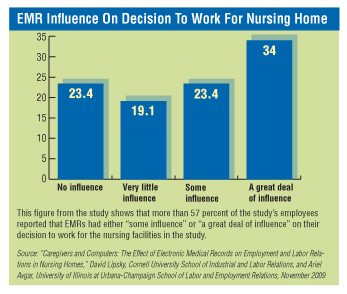 Caroline Rich decided some years back that the Brooklyn, N.Y., nursing facility she runs used entirely too much paper. She couldn’t get past what she saw: reams of paper being purchased for charting patients, keeping administrative records, and even for staff-to-staff communications, despite the fact most of her personnel had access to e-mail.
Caroline Rich decided some years back that the Brooklyn, N.Y., nursing facility she runs used entirely too much paper. She couldn’t get past what she saw: reams of paper being purchased for charting patients, keeping administrative records, and even for staff-to-staff communications, despite the fact most of her personnel had access to e-mail.
Rich and other managers at the Four Seasons Nursing & Rehabilitation Center pondered steps to reconcile their desire for less paper and corresponding hope for significant cost savings and efficiencies, not to mention improved care for their nearly 270 residents.
“About that time, there was the emergence of some national companies developing software for long term care, and then the grant from the QCOC fell into our laps,” Rich says, remembering what now has been a fortuitous turn of events for Four Seasons.
Grant Opportunity Opens The Door
QCOC is the Quality Care Oversight Committee of the 1199 SEIU (Service Employees International Union) Greater New York Worker Participation Fund, which was at that time looking for facilities to participate in a long-range study on the effect of electronic medical records (EMRs) on employment and labor relations in nursing facilities.
Rich’s facility joined 19 other New York centers that comprised the testing ground for the EMR study and eventually resulted in the release of a comprehensive 118-page report late last year detailing their mostly positive experiences in a “paperless” world. Rich’s take on the experience is more than positive.
In addition to the study’s installation of new software, between June 2007 and spring 2008 Rich undertook a sweeping review of the existing technology at the facility and made relatively easy and logical changes.
“We already had technology not being utilized, like internal e-mail,” she says, detailing how she got her own staff to avoid making lists on paper and use the fax machine’s scanning function to e-mail necessary documents instead of printing them out.
“It was about raising awareness. I mean, we use cell phones and other devices so why not use [technology] in our business?”
Meanwhile, while Rich was raising the bar on reducing paper through her home-grown initiatives and the new software, the overall study was focused on the larger issues of what it meant to bring technology to the seemingly neglected long term care sector. What the researchers eventually found was that many myths about nursing facilities and EMRs melted away under closer examination.
Myths Dispelled
What myths? Well, the one that nurses and certified nurse assistants would object to paperless systems by either quitting or not using the computers, or be unable to adapt to the technology.
“EMRs did not affect the ability of the nursing homes to retain their employees; attrition rates were identical in the treatment homes and the control homes,” the report said.
Of the 20 facilities taking part, 15 were upgraded with EMRs and five remained in traditional mode to allow researchers to compare and contrast the two.
In fact, the adoption of EMRs actually attracted workers, the report concluded. Other positives were that employees in EMR facilities reported fewer conflicts with colleagues, experienced better communication with supervisors, were able to devote more time to resident care instead of paperwork, and noted fewer medical errors and near misses.
Report authors—David Lipsky of Cornell University and Ariel Avgar of the University of Illinois at Urbana-Champaign—summarized that the evidence they compiled showed excellent results, with the vast majority of facilities using electroni

c documentation at rates of more than 90 percent.
“The demonstration project, judged on technical grounds, was a remarkable achievement,” the report said. The results did caution, however, that positive outcomes depended greatly on a cooperative style of management at the individual homes, namely, in getting workers to buy into the notion of a mostly paperless world.
Rich says the Four Seasons has millions of reasons to want to stay paperless, as in the number of dollars she estimates the five-year software lease will provide her facility. “Our return on investment should be around $4 million,” she says (Four Seasons is two-and-a-half years into its software lease), noting that number could be higher when all is said and done. These cost savings come from not having to buy as much paper, time savings for workers, elimination of newly unnecessary staff for maintaining paper medical records, redirected staff resources and equipment, and pharmacy costs.
“We can now see, through the software tracking, what medications new admits use and see how that compares with our formulary and avoid unnecessary and excessive medication. These are quality-of-life issues,” Rich says.
For More Information
- To read more about the long-range study on the effect of EMRs on nursing staff and their job satisfaction, including an executive summary and other information, go to: www.ilr.cornell.edu/conflictRes/research/nursingHome.html.
Patrick Connole is Provider's senior editor.